glass, ishizuka, japan
Ishizuka: Japanese Glassware Fit for Nobility
Christian Closs
Posted on April 18, 2022
Share:
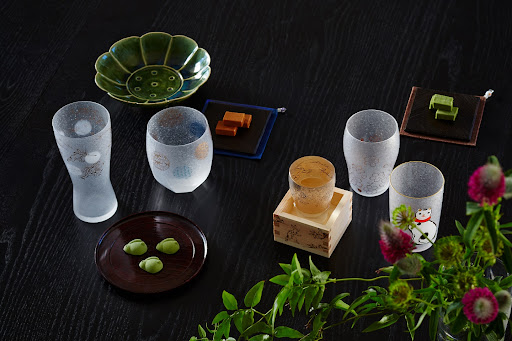
Japan’s history of making glass is still a comparatively young one, with the first Japanese glass artisans getting to work in the 17th century. Aichi prefecture’s glass experts Ishizuka started with small, one-off art pieces in the 19th century, before eventually supplying postwar Japan’s burgeoning Japanese middle-class with consumer glassware.
Glass in Japan
While simple glass beads were present in Japan as early as 400 AD, more elaborate glassware would not appear in the country until foreign traders brought it with them in the 16th century. The Portuguese were the first to establish trade with Japan around 1542, and alongside their Christian missionary efforts, brought items made from glass.
From glassware to mirrors and telescopes, these items were highly prized objects at first and mostly traded between the upper class. The novel material made an impression, and Japan continued to import and study it even after embarking on a policy of national isolation from 1639. Despite effectively banning foreigners from setting foot on Japanese soil, some limited trade continued with the Dutch.
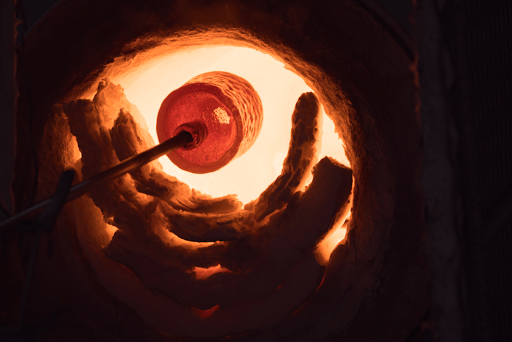
The only accessible port for these Dutch traders was located on Japan’s southern island of Kyushu. With certain foreign goods allowed in the country but books initially banned, Japan’s first glass artists had to learn by imitation, trial and error. Applying a Japanese approach to a European glass style, it wouldn’t take long for distinct Japanese styles to emerge.
Interested in learning more about Japan by trying out traditional Japanese snacks and tea? Sakuraco sends traditional Japanese snacks and home goods, including glassware from Ishizuka Glass, straight to your door.
Glass as Luxury
Glass would remain a luxury item for some time, but slowly spread to the rest of the country as wealthy feudal lords grew interested in it. Small glass workshops started springing up, and regionally different styles developed.
Ishizuka Glass
Ishizuka Glass’ story begins with founder Iwasaburo Ishizuka in 1819. Kyushu was still the heart of glass production in Japan, and Iwasaburo would first travel to Nagasaki to study the art of making glass. Upon returning, he set up a small workshop in Japan’s mountainous Gifu Prefecture, quickly making a name for himself as a pioneer in the region.
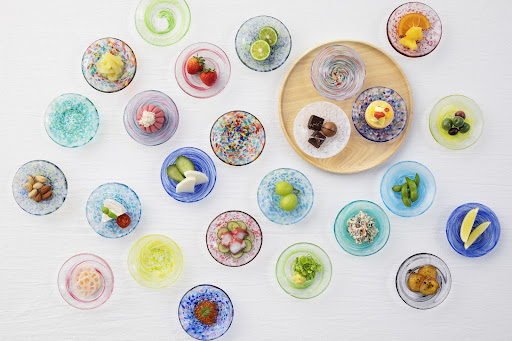
Iwasaburo eventually received an order for glass work directly from the feudal lord of his domain, cementing the workshop’s reputation and allowing it to grow. A few generations later, in 1888, the workshop moved to nearby Nagoya, Japan’s capital of manufacturing. Here Ishizuka was the first company in Japan to succeed in melting clear glass in a kiln suitable for mass production.
Quality Glass for the Masses
Japan was left in ruins after World War II, but its economy recovered at remarkable speed. By the 1950s the ‘economic miracle’ had allowed industry to reemerge and manufacturers eagerly got to work. As part of this new economy, a noticeably more modern middle class emerged with an appetite for consumer goods.
Ishizuka rose to the task, and through applying their Japanese craftsmanship to western style glassware, created a colorful tableware series that would soon be found in homes across the country. Called Aderia, the series featuring whimsical designs of flowers, fruit, and animals were so popular in fact, that Ishizuka Glass have recently reissued their designs from the 1960s and 1970s to overwhelming success.
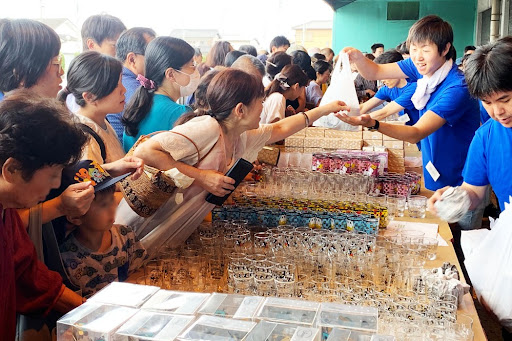
Modern Lineup
After supplying households nationwide with both printed and clear glassware, Ishizuka continued to develop new products in different styles. Western style beer glasses with Japanese graphics can be found side-by-side with unique Japanese designs, offering something for every taste.
Despite being one of the largest Japanese glass makers, Ishizuka still manages to retain a traditionally crafted look. By using traditional Japanese patterns, motifs, colors, and glass shapes, they offer something for everyone’s taste. Handmade, traditional Japanese glassware has also never disappeared from their lineup.
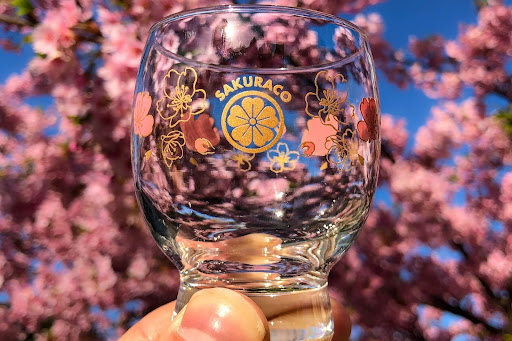
Their long history of quality, tradition, and unique Japanese expertise is why we reached out to collaborate with Ishizuka. Sakuraco is proud to have collaborated with Ishizuka Glass for a one-off exclusive cherry blossom sake cup in March 2022. Featuring cherry blossoms in bloom, the cup was inspired by and designed for enjoying a drink in the Japanese ritual of hanami, or flower viewing.
We are proud to be able to regularly partner up with companies like Ishizuka Glass to bring our Sakuraco subscribers high quality Japanese home goods. We exclusively work with local, history-rich businesses in Japan, to help support regional communities and precious traditions.

Discover authentic flavors with Sakuraco
Get Sakuraco 
1 Responses

Discover authentic flavors with Sakuraco
Get Sakuraco 
Related Articles

Hatsumode: Why Is It Japan’s Most Important Tradition?
Hatsumode is the first visit to a shrine or temple in the New Year in Japan, and it is one of the country’s most important traditions. Every year, millions of people participate, demonstrating the profound connection between this custom and daily life.

Japanese Fish Bait: The Beautiful Art of Kebari
Kebari are traditional hand-tied flies used for freshwater fishing in Japan, especially in mountain streams where small insects form the main diet of native fish. Instead of bright plastic lures, kebari use feathers, thread, and natural materials to create subtle movements in the water.

Japan Holidays Guide: Relax, Explore, and Delight in Festive Fun
As the year draws to a close, everywhere buzzes with preparations for the holidays, and Japan is no exception. Despite the cold winter weather, you can feel warmth in the scenery, decorations, and festive activities across the country. Let’s explore the unique experiences of holidays in Japan that many people dream of enjoying at least once in their lifetime!

Tokyo Gardens: Five Beautiful Traditional Japanese Gardens to Visit
Tokyo gardens offer a relaxing escape for visitors looking to get a breath of fresh air. However, Tokyo has more than just the typical gardens we see in the West. Let’s explore five traditional Japanese gardens and what makes them unique!




Love the Sakura glass included in our subscription box. It was beautiful & a perfect size for my daughter. Thank-you for including such a lovely piece of Japan.